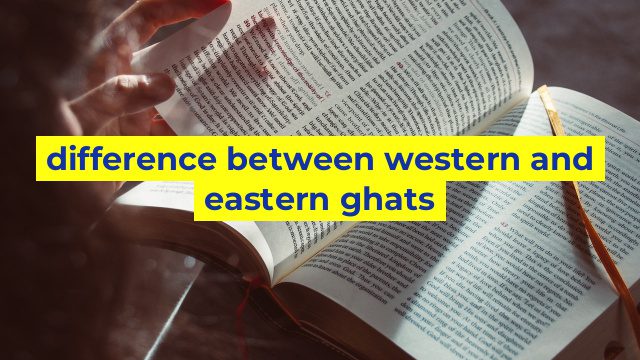Difference between Western and Eastern Ghats: An Overview
The Indian subcontinent is home to two major mountain ranges, Western and Eastern Ghats. Both of these ranges have played a major role in shaping the natural beauty of the region, but they differ in various ways. In this article, we will discuss the differences between the Western and Eastern Ghats.
Geography
The Western Ghats run parallel to the western coast of India, stretching from Gujarat to Tamil Nadu. This range is older and higher than the Eastern Ghats, with peaks like Anai Mudi and Doddabetta rising to over 2,000 meters. The landscape of the Western Ghats is characterized by high mountains, deep valleys, and dense forests.
The Eastern Ghats, on the other hand, run parallel to the eastern coast of India, stretching from West Bengal to Tamil Nadu. This range is younger and lower than the Western Ghats, with peaks like Jindhagada Peak and Mahendragiri rising to around 1,500 meters. The landscape of the Eastern Ghats is characterized by hills, plateaus, and dry forests.
Climate
The climate of the Western Ghats is moist and humid, with heavy rainfall during the monsoon season. This rainfall supports a diverse range of flora and fauna, including evergreen forests, grasslands, and wetlands.
The climate of the Eastern Ghats is relatively dry, with less rainfall than the Western Ghats. The region is characterized by scrub forests, thorn forests, and desert-like landscapes.
Biodiversity
The Western Ghats are known for their rich biodiversity and are recognized as a UNESCO World Heritage Site. The region is home to over 5,000 species of flowering plants, including 139 species of amphibians and reptiles, 508 species of birds, and 129 species of mammals.
The Eastern Ghats are also home to a diverse range of flora and fauna. The region is home to over 2,000 species of plants and 400 species of animals, including the Indian elephant, Bengal tiger, and Indian leopard.
Culture
The Western Ghats are home to many indigenous communities, including the Nilgiri tribes, the Toda and Kota tribes, and the Kadar tribe. These communities have lived in harmony with the natural environment for centuries and have a deep understanding of the region’s ecology.
The Eastern Ghats are home to many different communities, including the Kondh, Soura, and Gadaba tribes. These communities have a rich cultural heritage, with unique traditions, beliefs, and practices.
In conclusion, while the Western and Eastern Ghats share some similarities, they differ in terms of geography, climate, biodiversity, and culture. Both mountain ranges are a testament to the natural beauty of India and are important repositories of our ecological, cultural, and historical wealth.
Table difference between western and eastern ghats
| Western Ghats | Eastern Ghats | |
|---|---|---|
| Location | Runs parallel to the western coast of India | Runs parallel to the eastern coast of India |
| Length | 1600 km | 1300 km |
| Height | Taller and steeper | Lower and less steep |
| Biodiversity | Highly biodiverse with many endemic species | Less biodiverse with fewer endemics |
| Cultural significance | Important cultural and pilgrimage sites | Less significant culturally |
| Human population | More populated | Less populated |

